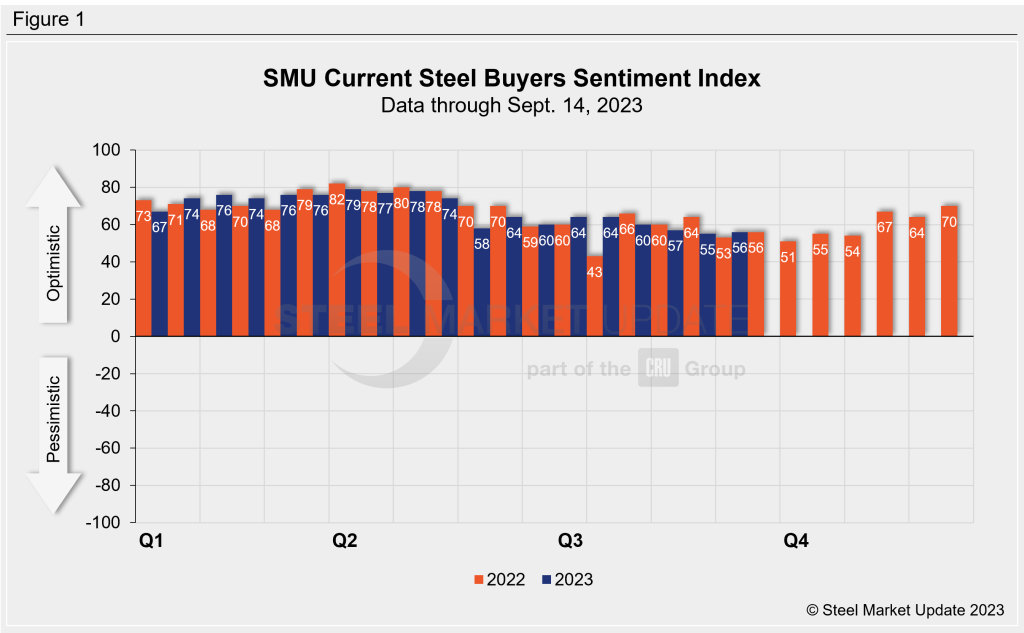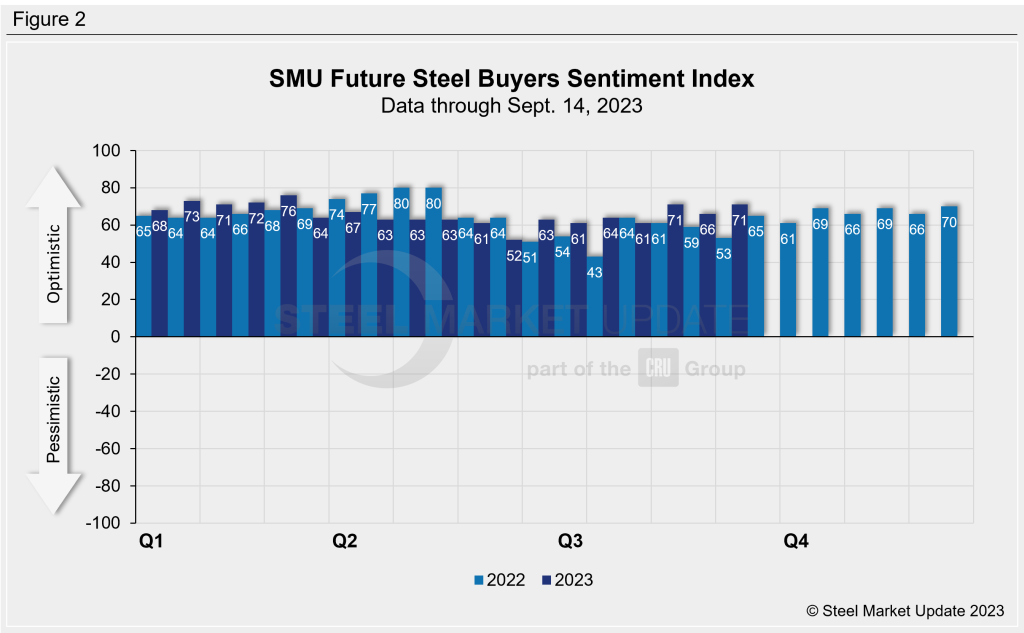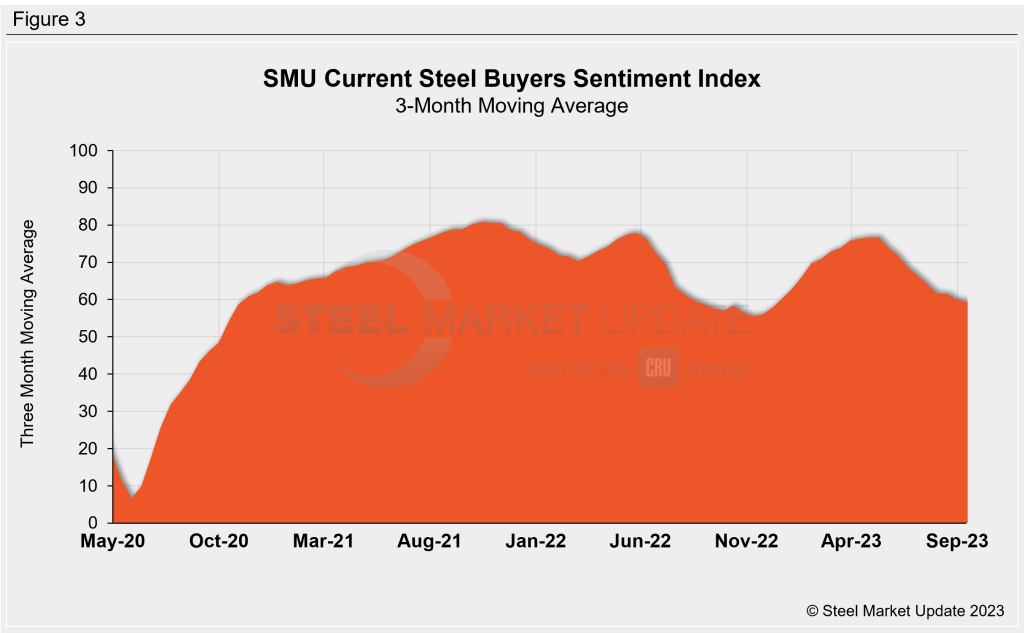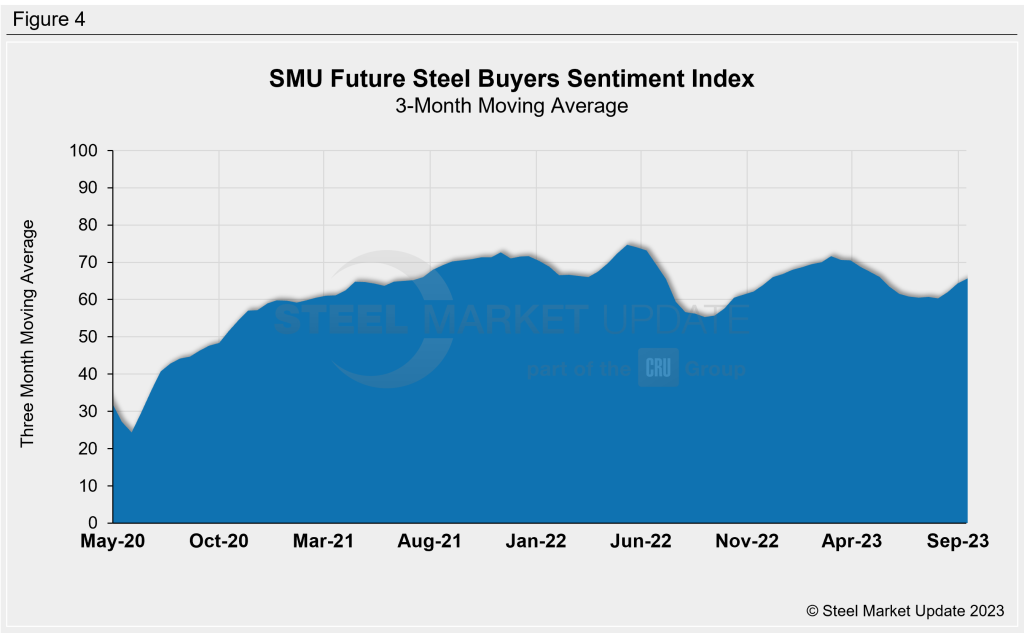SMU Data and Models
SMU Sentiment Indices Rose Ahead of UAW Strike
Written by Ethan Bernard
September 15, 2023
SMU’s Current and Future Steel Buyers Sentiment Indices both ticked up this week before the United Auto Workers (UAW) union strike was declared, based on our most recent survey data.
Every other week we poll steel buyers about sentiment. The Steel Buyers Sentiment Indices measure how steel buyers feel about their company’s chances of success in the current market, as well as three to six months down the road. We have historical data going back to 2008. Check our interactive graphing tool here.

SMU’s Current Buyers Sentiment Index stood at +56 this week, up slightly from +55 two weeks earlier (Fig. 1). Recall that the survey results were compiled before the UAW officially went on strike. At our next market check two weeks from now we’ll see the impact of the strike on current sentiment.
SMU’s Future Buyers Sentiment Index measures buyers’ feelings about business conditions three to six months in the future. This week, the index rose to +71 from +66 two weeks ago (Fig. 2). This marks the second time within a month the index has cracked +70. However, we will also see the effect of the strike on future sentiment two weeks from now.

Measured as a three-month moving average, the Current Sentiment 3MMA slipped to +59.33 vs. +60.00 at the last market check. (Fig. 3).

This week’s Future Sentiment 3MMA increased to +65.67 from +64.33 two weeks prior (Fig. 4).

What SMU Respondents Had to Say:
“We continue to gain market share and take full advantage of service centers lowering pricing week after week after week.”
“Order book is solid so far four months out.”
“We hope to continue with stable demand.”
“(Confident about next three to six months) as long as Infrastructure monies flow.”
“Spot buyers have pulled back due to auto strike negativity.”
About the SMU Steel Buyers Sentiment Index
The SMU Steel Buyers Sentiment Index measures the attitude of buyers and sellers of flat-rolled steel products in North America. It is a proprietary product developed by Steel Market Update for the North American steel industry. Tracking steel buyers’ sentiment is helpful in predicting their future behavior.
Positive readings run from +10 to +100. A positive reading means the meter on the right-hand side of our home page will fall in the green area indicating optimistic sentiment. Negative readings run from -10 to -100. They result in the meter on our homepage trending into the red, indicating pessimistic sentiment. A reading of “0” (+/- 10) indicates a neutral sentiment (or slightly optimistic or pessimistic), which is most likely an indicator of a shift occurring in the marketplace. Sentiment is measured via SMU surveys twice per month.

Ethan Bernard
Read more from Ethan BernardLatest in SMU Data and Models

SMU Survey: Sheet lead times ease further, plate hits one-year high
Steel buyers responding to this week’s SMU market survey report a continued softening in sheet lead times. Meanwhile, plate lead times have moderately extended and are at a one-year high.

SMU Survey: Buyers report more price flexibility from mills
Nearly half of the steel buyers responding to this week’s SMU market survey say domestic mills are showing increased willingness to negotiate pricing on new spot orders. This marks a significant shift from the firmer stance mills held in prior weeks.

SMU Survey: Buyers’ Sentiment Indices fall
Current Sentiment Index dropped six points to +42 this week compared to two weeks earlier. It has fallen in every successive survey since reaching a 2025 high of +66 on Feb. 19.

March service center shipments and inventories report
Steel service center shipments and inventories report through March 2024.

Apparent steel supply contracts in February
The amount of finished steel that entered the US market in February receded from January’s peak, according to our analysis of Department of Commerce and American Iron and Steel Institute (AISI) data.
